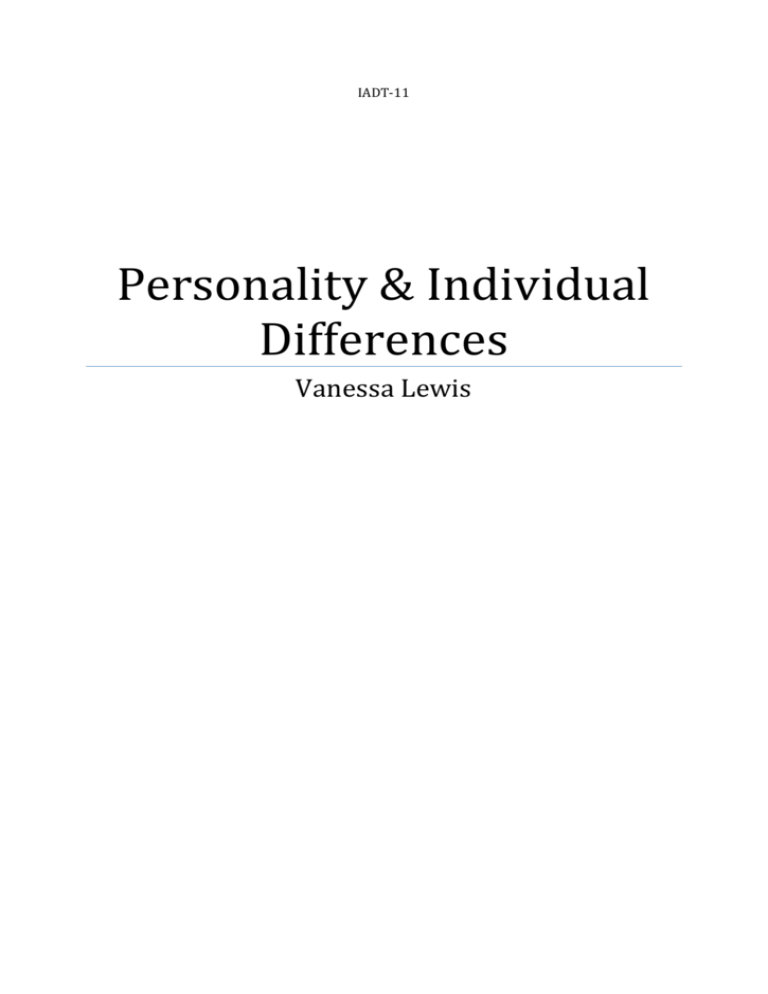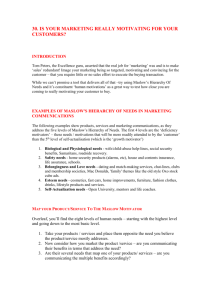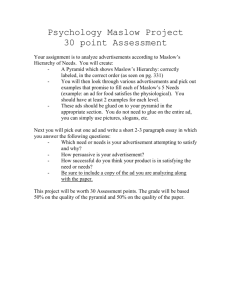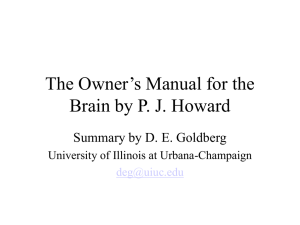Personality & Individual Differences
advertisement

IADT-11 Personality & Individual Differences Vanessa Lewis 1 Personality & Individual Differences Positive Psychology Maslow’s theory of self-actualisation "Self-Actualisation is the intrinsic growth of what is already in the organism, or more accurately, of what the organism is." Abraham Maslow. In Maslow’s hierarchy of needs theory, which appeared in his article ‘A Theory of Human Motivation’, he placed self-actualisation as the final level of psychological development. He loosely described self-actualisation as the full use and exploitation of talents, capacities, potentialities, etc. “(Motivation and Personality, p. 150). Maslow describes eight ways for a person to become self-actualised in his book ‘The Farther Reaches of Human Nature’ (Maslow, 1971). Concentration was the first, Maslow believed that deep concentration, heighten awareness and allowing something to absorb you is moments of self-actualisation. Number two of the eight ways is growth choices, people are faced with a series of choices throughout life; these choices are between growth and safety. Choosing growth is choosing openness to new challenges and experiences although the risks are unknown. The third way to become self-actualised according to Maslow is self-awareness; we become more aware of our feelings and shut out external influences. 2 Personality & Individual Differences Honestly and responsibility are fourth in Maslow’s theory, believed that taking responsibility for ones actions and living an honest life are important in becoming selfactualised. In step five is a person must learn trust their own judgement and inner feelings then act accordingly. Self-development is an on-going process in self-actualisation and number six according to Maslow’s theory. It is about utilizing the skills and intelligence a person has no matter how insignificance they seem to fill a person’s potential, it refers to a person whole life rather than a single accomplishment. Step 7 of Maslow’s theory of self-actualisation is peak experiences; these are moments when a person is more whole, more integrated, more aware of themselves and of the world. Some people have more peak experiences than others, Maslow called them transcending self-actualizers. The final phrase of Maslow’s theory of self-actualisation is lack of ego-defences, this is realising our defences and being able to control them so as not get in the way of a person reaching their full potential and becoming self-actualised. References Maslow, A. H. (1970). Motivation and personality (2d Ed.). New York: Harper & Row. Maslow, A. H. (1971). The farther reaches of human nature. New York: Viking Press. 3 Personality & Individual Differences Positive Psychology Martin Seligman’s idea of learned optimism ‘Learned Optimism: How to Change Your Mind and Your Life’ (Seligman, 1990) demonstrates the benefits of having an optimistic outlook on life and teaches how to become optimistic. There are differences between pessimists and optimists in the areas of permanence, pervasiveness, hope, and personalization according to Seligman. Permanence: for an optimist an unpleasant event is temporary rather than permanent, they will recover from quicker from failure. They will also feel that a good thing has happen for a reason and this will continue forever. A pessimist will feel that they unpleasantness is permanent and may never recover from it. Pervasiveness: pessimists will let failure affect all aspects of their lives, whereas optimists won’t. Also an optimist finds that a good event brightens all areas of their lives rather than just the part that event occurred in. Hope: optimists will find hope in all situations while pessimists will find a bad event permanent and see no hopeful outcome. Personalization: optimists are more confident in themselves and will blame failure on external events, they will internalize positive events. Whereas pessimists will blame their own short comings for failure and externalize success. Seligman came to this concept by scenically studying ‘learned helplessness’. Seligman then shifted his focus to discovering why some people never become helpless; his figured out it 4 Personality & Individual Differences was optimism so he began to condition people to become optimistic. The results led him to defining the processes of learning optimism. According to Seligman anyone can learn optimism; he developed a test to determine the level of optimism a person has and sort them onto a scale. Seligman’s process consists of 5 components; adversity, belief, consequence, disputation and energization (ABCDE). Teaching people learned optimism through ABDCE can help them deal with adversity they encounter in life. if taught to children in early life then the thought process of disputation becomes ingrained in them and they will automatically become optimistic through to adulthood which will lead to a more positive life according to Seligman. Learned optimism is also a tool used to combat depression during cognitive behavioural therapy. References Seligman, M. E. (1990). Learned optimism. New York: A.A. Knopf. 5 Personality & Individual Differences Reflective paper on wiki How did your group work? Why? What went well? My group worked well together on our wiki about B.F. Skinner, the work was shared out equally amongst all 4 members of my group. We divided the sections of the wiki up, each member had one section to do then we all did the home page, the references, the frequently asked questions and links we felt were useful for people studying Skinner. My group met up regularly to check on how everyone is getting along and try tackling any problems that had. What didn’t? How could these issues have been resolved? What did your group do to fix the problem? We didn’t have too many problems within the group. Our main problem was using the wiki spaces website, we found it hard to figure out how to link pages and add images. To overcome this problem we researched how to use wiki spaces by finding tutorials on YouTube. I found it hard to find reliable sources of information on the internet, this became very time consuming but it was beneficial for further studies. All problems that arose during this assignment were overcome with team; our group communicated with each other and shared ideas on our design and layout. How did the group approach the task of the wiki? Who did what? Did all approach the task with the same effort? When we were given the wiki we decided to firstly pick which software we wanted to use by research each programme. We chose wiki spaces as we felt it was the simple to use and the layout looked appealing to us. We studied how to use the wiki spaces site so we wouldn’t encounter too many problems when we were uploading our work. We divided each section up equally; I did the biography section on B.F. Skinner and referenced my work. Also we all worked on the homepage, the relevant links and frequently asked questions. We all put in a lot of effort and work until each member of the group was satisfied with our wiki. What were your personal thoughts on the assignment? Personally, I found the wiki interesting do to; I enjoyed making it and found it helpful to learn about Skinner. I now have a better understanding of Skinners life and theories. I would work with my group again as they are easy to work with and everyone did the same amount of work. We all got along well and motivated each other throughout the assignment. 6 Personality & Individual Differences Alice in Wonderland analysis When looking at the first scene of Alice in Wonderland. One can make some interesting Freudian analyses. When Alice chases the white rabbit into the hole and proceeds to fall down this hole, Freudian dream analysis tells us that falling in dreams represents sexual impulses. It is also believed that falling down the hole itself also represents sexual penetration. When Alice lands in the room at the bottom of the hole she is surrounded by a series of locked doors. Freudian analysis tells us that this symbolises Alice’s virginity. Some say that Lewis Carroll the author of Alice in Wonderland had an unhealthy sexual desire for young children and that this desire is symbolized in Alice’s choice to use the key to open the smallest locked door in the room. The door then leads to a garden which is seen as female sexual maturation. One could also say that Alice is too trusting at times, she confides in the caterpillar that she has only just met and tells him that she is basically going through an identity crisis “I can’t explain myself, I’m afraid, sir, because I’m not myself you see”. One could see her big imagination as an identity crisis, as she is struggling to get to grips with who she really is. She dreams up this wonderland as a way to escape reality but even in wonderland she finds it tough to be herself, all the times she shrinks and grows are symbols of what she is going through in real life, adolescence. "Identity crisis is the failure to achieve ego identity during adolescence" (Schultz, 216). Her growing can also be seen as Alice experiencing penis envy, her growing represents an erection. Alice talks about feet and her socks which can be seen as frustration over not having a penis. As the story goes on we can see her starting to use her experiences as a way of ‘finding herself’. “I wonder if I’ve been changed at night? Let me think. Was I the same when I got up this morning? I almost think I remember feeling a bit different. But if I’m not the same the next question is ‘who in the world am I?’ Ah, that’s the great puzzle.” At the end of the story we can see that through all her experiences and everything she has gone through in wonderland, she seems to have learned how to be herself. She stands up to the cards and in her fully grown state says “I’m not afraid of you. Why you’re nothing but a pack of cards” Successful resolution of the crisis depends on one’s progress through previous developmental stages, centering on issues such as trust, autonomy, and initiative (Schultz, 215-216).





